
Spring is happening and the forest is getting noisy again. Birds are staking out nesting territories, yelling their songs at competitors and potential mates. But a huge number of tiny creatures are still sleeping, in one form or another. And before the birds can get on with it, the insects must awake. These buzzing, humming, flying, crawling hordes are some of the most vital strands in the forest’s food web.

Recent studies of natural areas in Germany show a severe and rapid decline in insect biomass and diversity. Due to intensive land use practices, particularly agriculture, most of them are isolated in a sea of cropland. It got me to wondering about this little fragment of forest, surrounded by city. There has never been an arthropod survey carried out here, to my knowledge. The only real evidence we have are the photos I’ve been taking for this blog. Despite the fact I’ve only observed a tiny percentage of this forest’s insects (and related arachnids, myriapods and crustaceans), I want to share with you what I’ve seen. So brace yourself for a very long post! The pics are quite obviously skewed toward the showier and more easily photographed ones (apologies to those hugely abundant gnats and mosquitos).
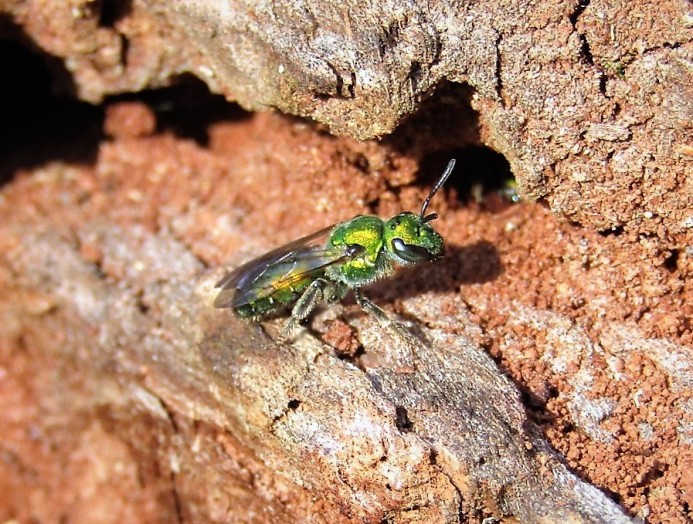
Sometime in the next couple weeks, female Pure green sweat bees will emerge from their nests inside rotten logs. (Their very long common name is just a translation of the latin Augochlora pura). Last spring, the bee in the pic above was part of a small colony nesting inside the crumbling remains of a fallen Black cherry.

Geometrid caterpillars, commonly known as loopers, are among the hundreds of species of moth caterpillars (in this forest alone) that will soon be crammed into the gaping mouths of baby birds. Thanks to the research of Dr. Doug Tallamy (author of Bringing Nature Home), we’ve learned that some plant species support vastly more caterpillars. Oaks are at the top of this (very abbreviated) list, which makes a good guide for restoration tree planting.
Woody plants, number of Lepidoptera species supported: Oak 534, Black cherry 456, Willow 455, Birch 413, Poplar 368, Crabapple 311, Blueberry 288, Maple 285, Elm 213, Pine 203, Hickory 200
The unidentified looper above likely doesn’t have a common name, but the “Spicebush leaf petiole mimic” would be very apt.

A four foot Catalpa sapling hosted a whole congregation of Catalpa sphinx moth caterpillars last summer. Which also benefited a parasitoid wasp, whose numerous egg clusters can be seen on one of the caterpillars.
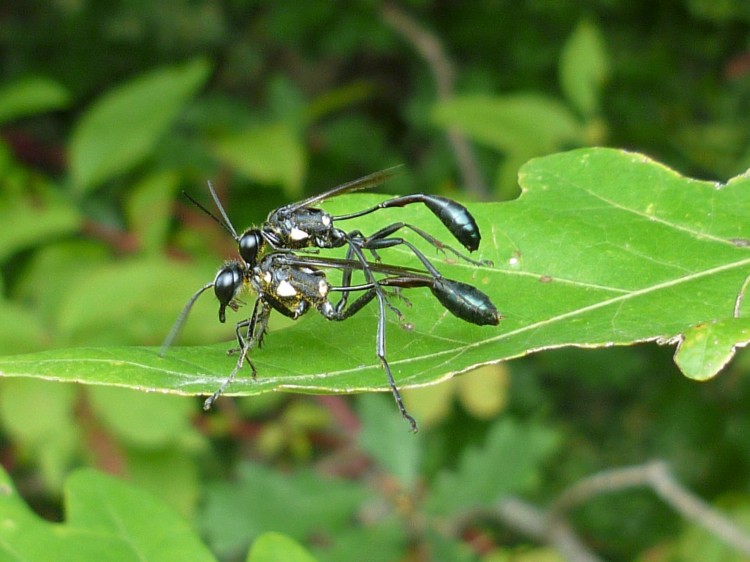
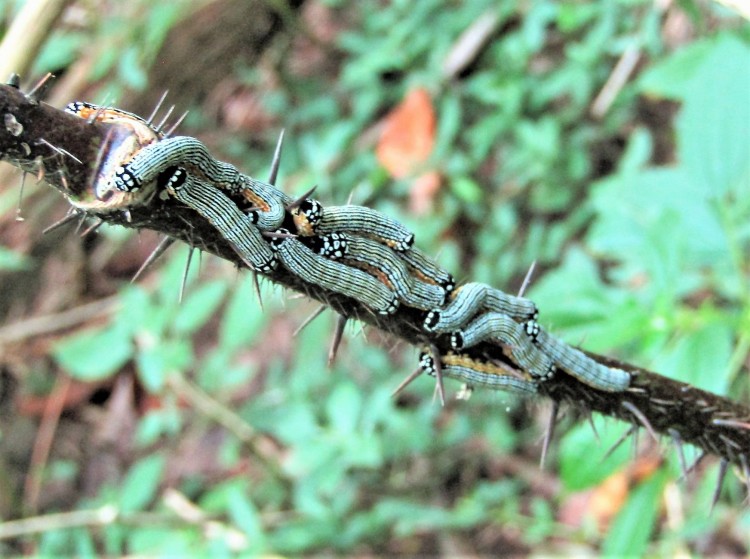
The significance of host plant diversity goes well beyond tree species. A single plant genus – Smilax (Greenbriar) hosts the pin stripe patterned Turbulent phosphila caterpillar, often in crowded congregations. When I see a patch of Smilax vines I try to protect it from the ravages of deer, since the tender shoots are a favored menu item.

It’s often stated that invasive plants are ecological dead zones, having been separated from their own insect communities. But there can be exceptions. The native Laurel sphinx caterpillar above has been observed here on several occasions, feeding on the leaves of invasive Japanese privet. This sphinx moth has a close relative called the Privet sphinx, which lives in the wide Eurasian range where privet species are native. The larvae of both sphinx moths feed on plants in the olive family, which includes privet.

The acid yellow Ruddy dagger moth larva belongs to a group referred to as tussock moths, all of whom are seriously hairy, and some of whom carry stinging hairs as well. Elm and Hackberry are among its host plants.

The larvae of some butterflies have evolved to feed on only one genus or family of host plants because they contain noxious chemical compounds. The Monarch butterfly is a well known example, but the Zebra swallowtail likely also uses this strategy.
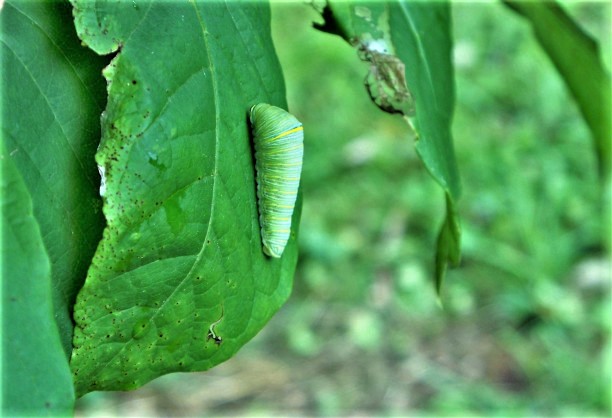
Its one host plant, Pawpaw, contains potent chemical compounds called “annonaceous acetogenins”, which confer a degree of protection from birds. As the number of Pawpaw trees in this forest increases, we’ve begun to see this species regularly.
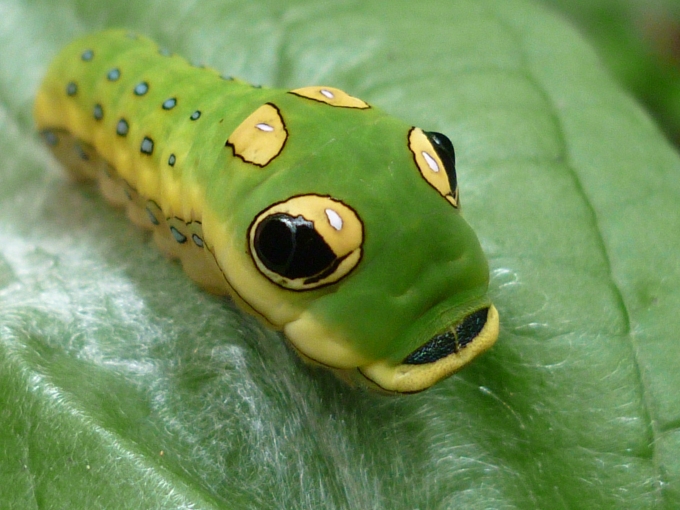
The Spicebush swallowtail caterpillar, when disturbed, sprouts a yellow, foul-smelling, forked gland behind it’s head. This organ, the osmeterium, is unique to swallowtails and its odor is fueled by the aromatic plants they feed on. The Spicebush larva has more than one defense strategy, enfolding itself in a spicebush leaf by means of a silken web. Should the larva be discovered by a bird, the huge eyespots will hopefully frighten it away.
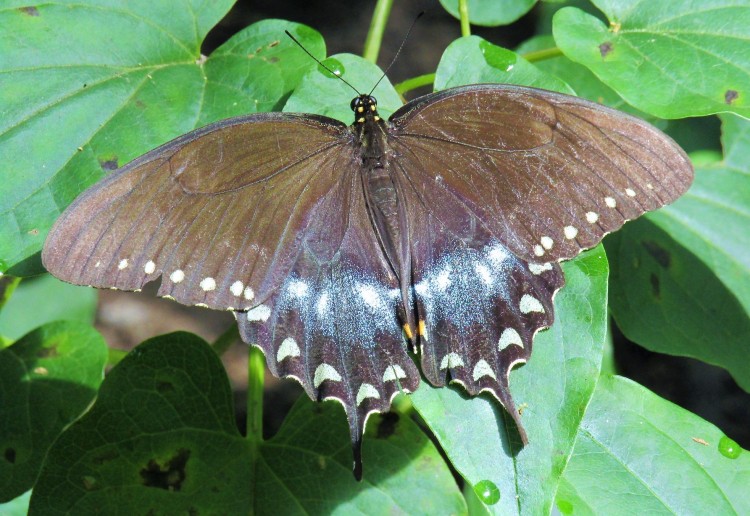
Lepidoptera are a good measure of diversity since their larvae feed on a wide variety of plants. It’s a joy to see both the number of species and individuals increasing as the herbaceous layer in this forest revives. The butterflies and moths below were observed last summer; the wide range of host plants utilized highlights the importance of plant diversity.

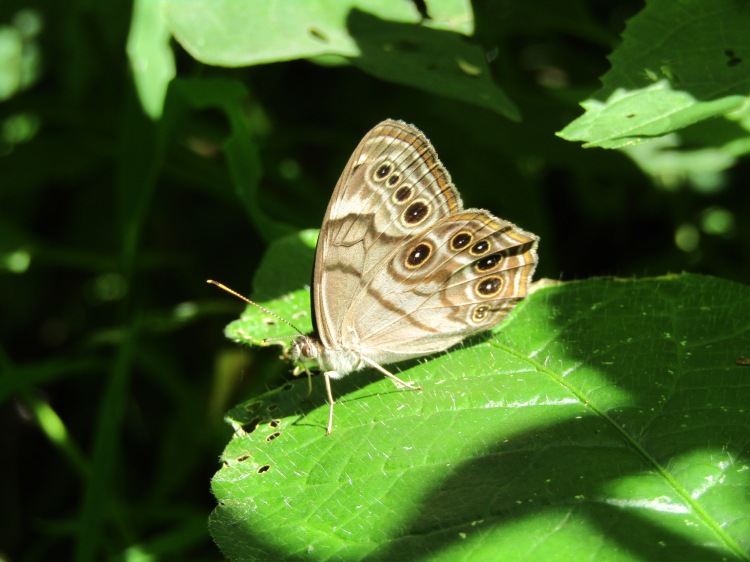
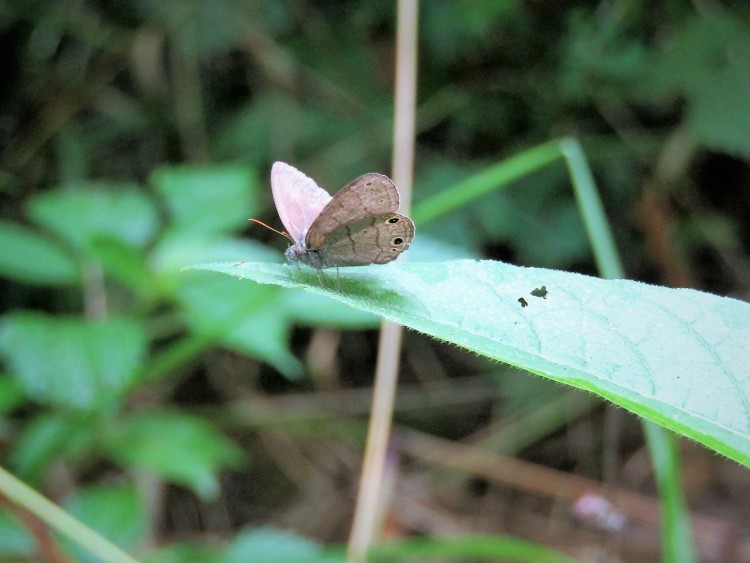
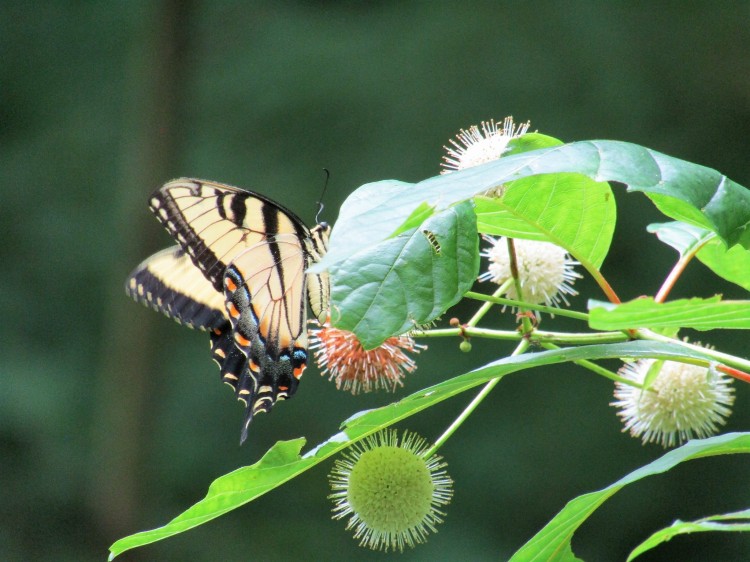

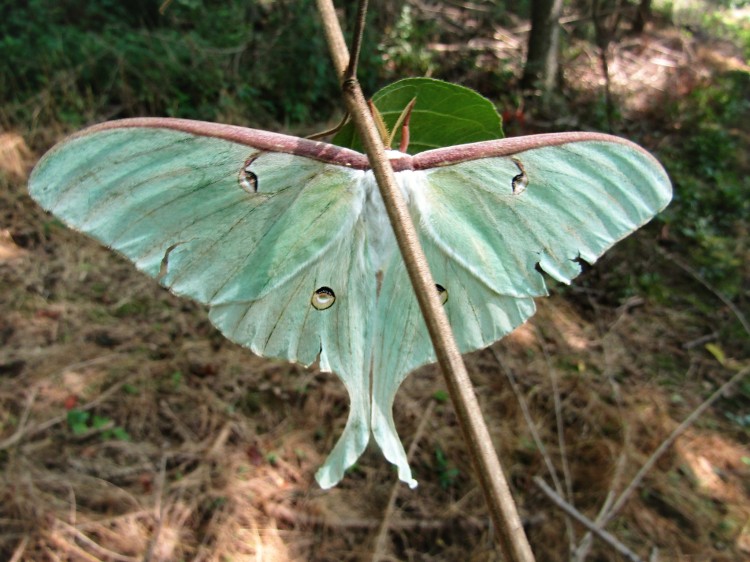
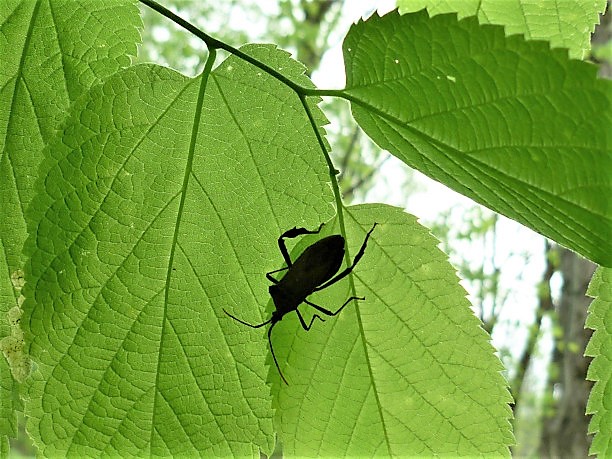
When is it ok to call an insect a bug? Answer – when it’s a true bug, order Hemiptera! True bugs, which include cicadas, aphids, stinkbugs, bedbugs, assassin bugs, and leafhoppers, are mostly suckers of plant juices. The Leaf-footed bug above is considered an agricultural pest, since its long piercing mouth parts can penetrate fruits, vegetables, nuts and seeds.

Male leaf-footed bugs establish territories and battle with other male intruders.

Stink bugs are part of the clan too; the colorful one perched on a jewelweed leaf is a third instar of the common Green stinkbug.

Though Cicadas look rather different from most other true bugs, they have piercing mouth parts, and both larvae and adults drink plant sap.

The Wheel bug (named for the spiny ridge on its thorax) uses its piercing mouth parts in a different way. This large, sturdy assassin bug injects prey with tissue-dissolving saliva, then sucks it dry. Many caterpillars and beetles are on the menu, since it is not deterred by armor or long stinging hairs.

Speaking of predators, the Carolina mantis is less commonly observed than the introduced European and Chinese species, but I see them more often in sunny parts of the forest. Though they can be green, all the ones I’ve observed are brown/grey camo patterned.
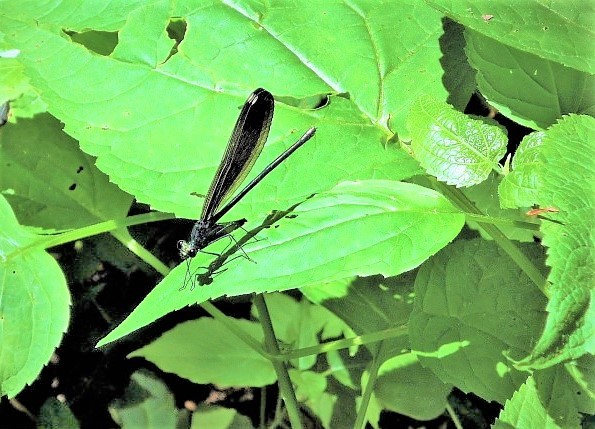
Damselflies and Dragonflies are well known insect predators, and I’ve been seeing greater numbers of one in particular – the iridescent blue-green Ebony jewelwing. Since their larvae are aquatic, this may be due to increased rainfall keeping the wetlands full of water till early summer.
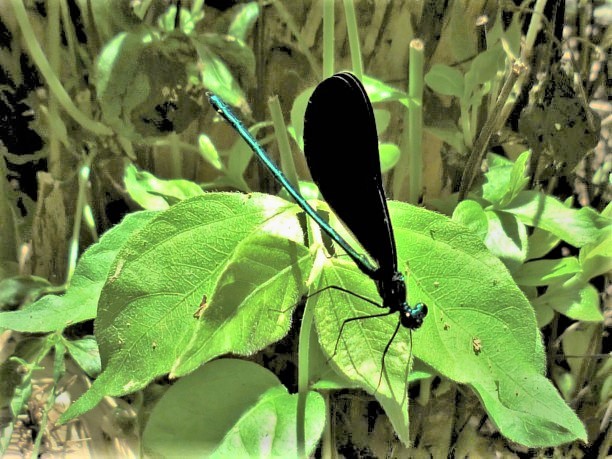


And yet another predator, the Six spotted tiger beetle, is commonly observed hunting on the trails in summer. Most of my images (like this one) are of torpid beetles hibernating underground, that I dug up while planting!

Though beetles are the most diverse insect group, I only have images of three of the showier species.
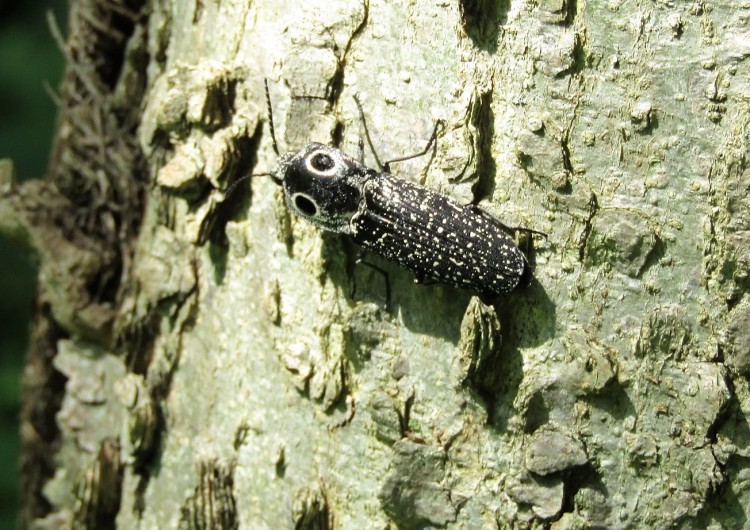
The Eastern-eyed click beetle may look intimidating due to its size (one inch or more in length) but only it’s larvae, like those of many beetles, are predatory.

One tiny species of beetle has completely changed this forest in just ten years time. The larva of the invasive Emerald ash borer beetle tunnels through the cambium of mature ash trees, slowly killing them. Though dead ash trees are abundant, I have yet to see an adult or larval ash borer.

Most of the katydids I found as a child had already expired, so could study them at my leisure. It’s rare to observe them any other way, since they spend their lives high in the trees. But this male Common true katydid must have lost his footing and fallen (those leafy looking wings are only good for gliding and fluttering).
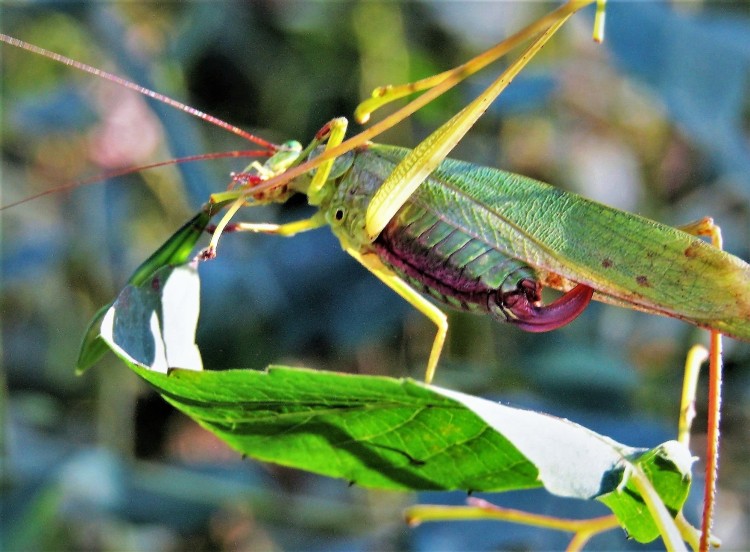
A female Fork tailed bush katydid munches on a jewelweed seed pod. The reddish “fork tail” is really her ovipositor, which she uses to insert eggs between the layers of a leaf.
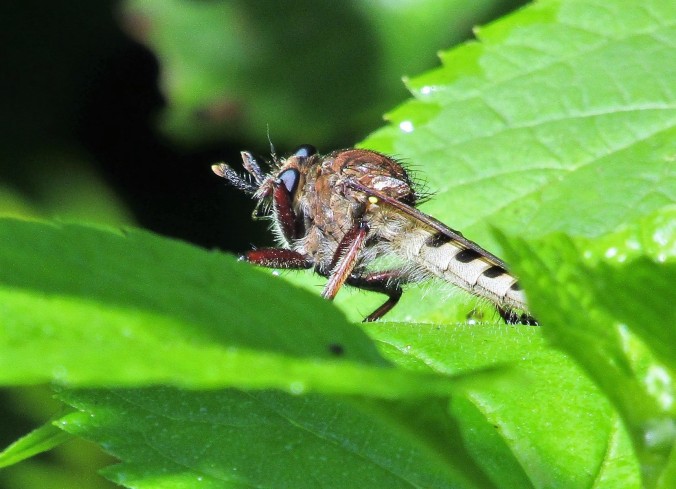
A huge eyed robber fly watches for prey from its leafy perch. These fearsome looking predators have been observed attacking prey larger than themselves, even hummingbirds!

The poor crane fly inspires shrieks and arm waving due to it’s mosquito-like appearance. However it can’t bite anything and only lives long enough to complete the breeding cycle.

I had a hard time ID’ing the little known Snipe fly, which hatched out in great numbers in the spring of 2017.
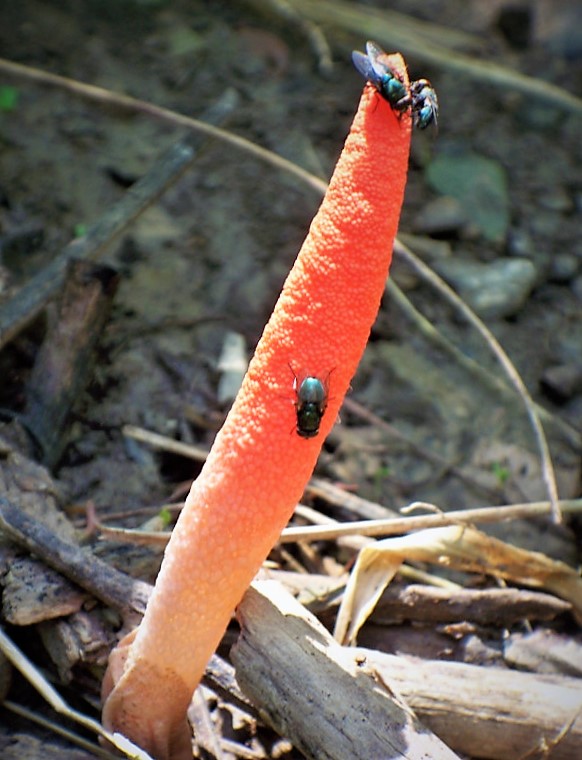
Blow flies, like these Blue bottle flies, are attracted to smelly things since they lay their eggs on carrion. This has led to the evolution of smelly flowers, like those of the native Pawpaw, which utilize them for pollination. Some mushrooms are in on it too – stinkhorns produce a very unpleasant smelling slimy layer of spores, the “gleba”. When flies walk around on it they pick up spores on their feet.

Not an insect, but included because it’s one of the most commonly observed arthropods in this forest. Despite the myth, the Harvestman or Daddy long-legs is an omnivore; it has no poison glands and doesn’t bite people. It’s an Arachnid but isn’t a spider.
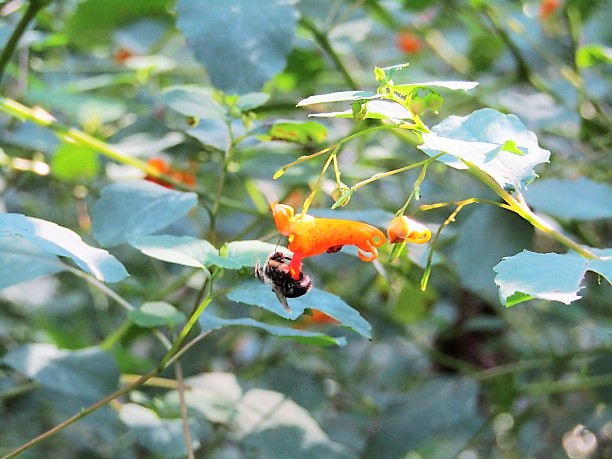
If you’ve actually read this entire long post, I hope you have a greater appreciation for the diversity of insects that live in even a small urban forest. Many of these insects could thrive more widely in city landscapes if their host and nectar plants were available. Now it’s up to you, dear reader – what can you do to welcome the bug life into your space?
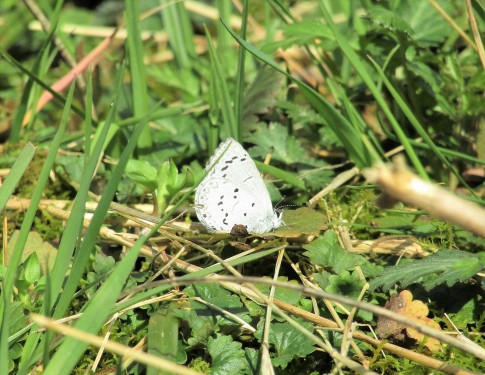

Owen C. Hardy
What an “Easter Parade” of gorgeous bug life! And all in our tiny neighborhood urban “forest fragment!” Thanks — again — for the display.
LikeLiked by 1 person
oneforestfragment
You’re welcome, I finally got to use all these bug pics!
LikeLike
Deany
Wonderful! I am one that use to shriek and run from bugs. Now I am fascinated. This will help me to identify bugs I see in my backyard habitat. It is a good reference. I always enjoy reading your post and the pictures are helpful too! Thank you for all you do!
LikeLiked by 1 person
oneforestfragment
Thank-you! I enjoy the regular updates from your wild space on Wild Ones Louisville – very inspiring.
LikeLike
Roger
Wonderful Rosemary!! So much interesting information. Thanks for all you do.
LikeLiked by 1 person
oneforestfragment
Thank-you for all you do too! I had to learn a lot to write it.
LikeLike
shoreacres
What an amazing collection. Your photos are wonderful, and the creatures themselves certainly are compelling!
LikeLiked by 1 person
oneforestfragment
Thank-you! It was a long one to write, and these more charismatic species are probably less than 5% of what’s here.
LikeLiked by 1 person
Phyllis Fitzgerald
These insects are beautiful and interesting. Thanks for photographing them and providing names.
LikeLiked by 1 person
oneforestfragment
Thank-you! It took a good bit of google research to find all those names, but now I know them too.
LikeLike
Anonymous
What a beautiful and informative post – I appreciate this respite from the incessant but necessary updates of the current state of our world.
LikeLiked by 1 person
oneforestfragment
Me too – thank-you! It’s good to remind ourselves that life goes on and we humans are not everything.
LikeLike
tonytomeo
‘Bugland’ sounds like the Capitol of Iraq.
Regardless, it really is an impressive ‘Easter Parade’!
LikeLiked by 1 person
oneforestfragment
Thank-you! Apparently I stole the title unknowingly from a children’s book. Since we aren’t going to have much in the way of Easter celebrations, we can just celebrate bugs. Walking in the woods is the only thing left to do, so why not?
LikeLiked by 1 person
tonytomeo
‘Bugs’ was a bad word when I was in school. It is too often used to describe all insects, and sometimes arachnids, but it is actually a technical term for the insect family of Hemiptera. We learned to only use it as such. In the same manner, we were not to use the word ‘dirt’ to describe soil.
LikeLiked by 1 person
oneforestfragment
Hemiptera – the only true bugs (includes bedbugs)!
LikeLiked by 1 person
tonytomeo
ew! but, yes.
LikeLiked by 1 person
Jim Sky
What a wonderful post. Given the number of years I probably have left on the planet, I wish there was a way to do a direct data dump of your nature knowledge into our brains, but this is fun too. Thanks.
LikeLiked by 1 person
oneforestfragment
To be honest Jim, I spent over a month plying my research assistant Google Images with sentences like “black and white moth with orange legs” just to write this post! But I did learn some things too.
LikeLike